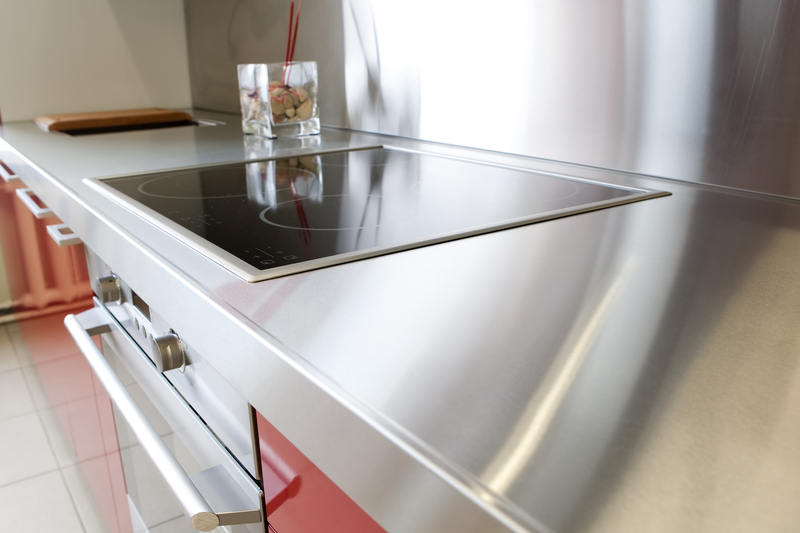How to Effectively Scrub Burnt-on Deposit From Your Stove Surface
Posted on 23/05/2025
How to Effectively Scrub Burnt-on Deposit From Your Stove Surface
A stovetop is a workhorse in the kitchen, enduring everything from sizzling stir-fries to late-night boiling mishaps. However, burnt-on deposits and stubborn stains can quickly transform your once-gleaming stove into something you'd rather not show off. If you're struggling with unsightly burnt food or stubborn grime, fear not! In this comprehensive guide, you'll discover the most effective methods to scrub burnt-on deposits and restore your stove surface to its original shine.
Why Clean Burnt-on Deposits Promptly?
Cleaning off burnt-on residue as soon as possible is crucial for several reasons:
- Extended appliance lifespan: Built-up residue can corrode or damage your stove surface over time.
- Safety: Grease and burnt foods can become fire hazards if left unattended.
- Hygiene: Old deposits can harbor bacteria and odors.
- Efficiency: Clean burners ensure optimal heat distribution for cooking.
- Aesthetics: Nothing beats the look of a sparkling-clean stove!

Understanding Your Stove Surface: A Crucial Step
Before you scrub burnt-on deposits, it's vital to know what kind of stove you have, as each surface type requires a different approach:
- Gas Stoves: Feature removable burner grates and pans, typically made of enamel, stainless steel, or cast iron.
- Electric Coil Stoves: Feature removable heating coils with metal drip pans underneath.
- Glass or Ceramic Cooktops: Flat and smooth; require gentle, non-abrasive cleaning methods.
- Induction Cooktops: Look similar to glass but use magnetic induction heating; treat similarly to glass surfaces.
Always check your stove's user manual for recommended cleaning procedures and products.
The Tools and Supplies You'll Need
Having the right tools makes effective cleaning much easier and safer for your appliance. Here's what you'll likely need to remove burnt-on residue:
- Baking soda
- White vinegar
- Dish soap
- Lemon juice (optional for extra grease busting)
- Non-abrasive sponges or microfiber cloths
- Plastic scraper or old credit card
- Razor blade scraper (only for glass top stoves, used carefully)
- Paper towels
- Soft bristle brush (optional)
- Rubber gloves (for sensitive skin)
Step-by-Step Methods to Remove Burnt-on Deposits From Your Stove Top
1. Preparation and Initial Cleaning
- Ensure Safety: Always turn off the stove and make sure it's completely cool before cleaning.
- Remove loose debris: Use a dry paper towel or soft brush to wipe away loose crumbs and food bits.
- Detach removable components: For gas or electric stoves, remove burner grates, drip pans, and knobs if possible.
2. Soak and Loosen the Burnt-on Stains
- Apply Hot Soapy Water: Fill a sink or a basin with hot water and a few drops of dish soap. Soak grates and drip pans for at least 20 minutes. For stovetop surfaces, place a hot, damp towel over the stain to loosen it.
- Spot Treatment: Mix equal parts vinegar and water in a spray bottle. Spray directly onto burnt residues and let it sit for 10 minutes.
- Bonus Tip: Sprinkle baking soda liberally over stubborn spots, then spray with vinegar. The fizzing action helps break down the residue.
3. Scrubbing and Removing the Burnt-on Deposits
- For Metal Grates and Drip Pans:
- After soaking, scrub with a non-abrasive sponge or brush. For stubborn spots, create a paste of baking soda and water, apply, and let sit for 15 minutes before scrubbing.
- Use an old toothbrush or a soft bristle brush for crevices.
- For Stove Surfaces (Metal or Enamel):
- Apply the baking soda paste directly onto the burnt-on stains.
- Let it sit for at least 15-30 minutes.
- Gently scrub using a non-abrasive sponge in circular motions. Never use steel wool, as it can scratch precious enamel.
- Effective Methods for Glass or Ceramic Cooktops:
- Baking soda and vinegar method: Sprinkle baking soda on burnt areas, then drizzle with vinegar. Cover with a warm, damp towel for 15 minutes. Gently scrub with a microfiber cloth.
- Plastic scraper or razor blade scraper: For extra stubborn spots, carefully use a razor blade at a 45-degree angle to gently lift charred remains; always keep the area wet to avoid scratching.
- Dry with a clean, soft towel or paper towel.
4. Targeting Extra Tough, Stubborn Burner Stains
Sometimes, burnt-on deposits just won't budge with basic scrubbing. Here's what to try next:
- Lemon Power: Cut a lemon in half, sprinkle with salt, and rub directly onto the stain. The acidity helps dissolve burnt-on food and kills bacteria.
- Baking Soda Paste Overnight: For extreme cases, apply a thick layer of baking soda paste and leave overnight, covered with a damp cloth. The stain should be easier to lift the next morning.
- Ammonia (for grates only): Place grates in a sealed plastic bag with 1/4 cup ammonia overnight (outside, due to fumes). Rinse thoroughly before use.
Common Mistakes to Avoid When Cleaning Your Stove
- Using abrasive cleaners: Steel wool or harsh scouring pads can permanently scratch most stove surfaces.
- Applying too much water near electrical components: Always avoid soaking knobs or letting water seep beneath the surface, especially on electric or induction stovetops.
- Neglecting to rinse and dry: Cleaning residues left behind can burn and create new stains the next time you cook.
- Ignoring manufacturer instructions: Some cooktops require specialized cleaning products--read your manual!
Green, Eco-Friendly Ways to Remove Burnt-on Deposits
- Baking Soda: An all-natural mild abrasive that lifts even tough stains without scratching.
- Vinegar: Dissolves mineral deposits and breaks down grease grime.
- Lemon Juice: Cuts through grease and imparts a fresh scent.
- Hydrogen Peroxide: Mix with baking soda for a fizzing stain-lifter that's non-toxic.
- Olive Oil: Just a few drops on a cloth can help polish and break down burnt food residues on stainless steel.
Choose these natural alternatives whenever possible for a safer, healthier home environment.
How to Keep Your Stove Surface Free of Burnt-on Deposits
1. Clean After Every Use
- Wipe down with a damp cloth after cooking to prevent the buildup of residue.
- For quick touch-ups, a vinegar and water spray works wonders to keep surfaces shiny and grease-free.
2. Address Spills Immediately
- Spills become much harder to clean once they're burnt on. Blot up spills with a paper towel as soon as they happen if it's safe to do so.
3. Deep Clean Weekly
- Once a week, remove all grates and drip pans for a soak-and-scrub session. This prevents heavy buildup.
4. Protect Your Cooktop
- Use drip protectors, stovetop liners, or foil (where applicable) to catch spills before they hit the surface.
- For glass or ceramic tops, avoid sliding heavy pans to prevent scratches and food smears.
Frequently Asked Questions About Scrubbing Burnt-on Stove Deposits
What is the best way to scrub burnt-on food from a glass stove top?
The most effective method for glass tops is a combination of baking soda and vinegar, followed by gentle scrubbing with a microfiber cloth. For extra-tough stains, use a razor blade scraper, always keeping the surface wet to protect against scratches.
Can I use a Magic Eraser on my stove's burnt-on stains?
Yes, Magic Erasers (melamine foam) can help lift tough stains, especially on glass and enamel. However, test on a small area first, as some surfaces may dull or scratch.
Are commercial stove cleaners necessary for burnt-on deposits?
Commercial stove cleaners are effective but not mandatory. Many burnt-on stains can be removed with household items like baking soda, vinegar, and dish soap. However, specialty cleaners can save time for especially challenging stains.
Will regular dish soap remove burnt-on residue?
Dish soap alone is often not strong enough for fully burnt-on, carbonized food, but it does help loosen and cut through grease, making it a good first step in the cleaning process.

Top Tips for an Effective and Easy Burnt-on Deposit Removal
- Allow time for solutions to work. Letting baking soda paste or vinegar sit gives them time to break down stubborn residues.
- Be gentle. A non-abrasive sponge and patience prevent expensive scratches.
- Work in small circles. Circular scrubbing motions tend to be most effective.
- Rinse thoroughly. Remove all cleaning residues to avoid future burning or streaks.
- Dry completely. Moisture left behind can lead to rust or streaks, especially on stainless steel and enamel surfaces.
Summary: Restore Your Stove's Sparkle with These Proven Techniques
With the right approach, scrubbing burnt-on deposits from your stove surface doesn't have to be a dreaded chore. Start with gentle, household ingredients and work your way up to stronger methods only as needed. By cleaning regularly and caring for your stove, you'll ensure it remains a beautiful and functional centerpiece of your kitchen for years to come.
Remember:
- Identify your stove surface before cleaning
- Use the appropriate technique--baking soda and vinegar are your friends!
- Be patient; sometimes the solution is just giving the cleaner a bit more time to work
- Maintain your stove with quick cleanups after every meal
For stubborn burnt-on deposits, don't hesitate to use specialty tools or reach for commercial cleaners as a last resort--but most messes can be managed with a gentle, eco-friendly approach.
Now you know exactly how to effectively scrub burnt-on deposit from your stove surface--so go ahead and restore your kitchen's brilliance today!




